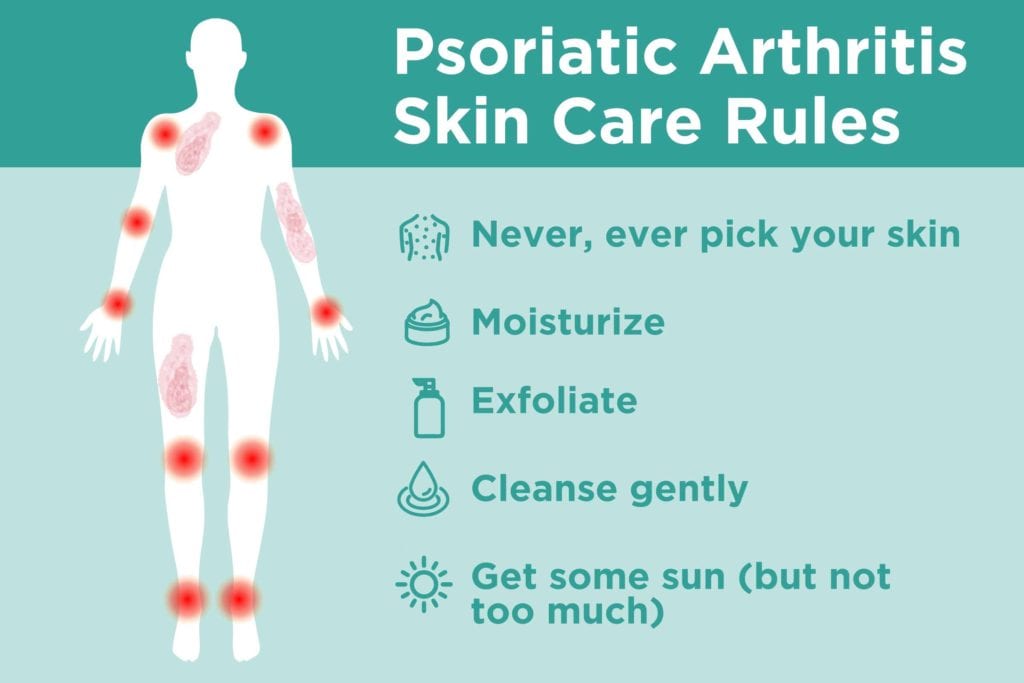

Many people who develop psoriatic arthritis (PsA) call it the “double whammy” — and rightfully so. With psoriatic arthritis, a type of joint inflammation that occurs along with the skin disorder psoriasis, you not only have to manage the pain, stiffness, and fatigue that often accompanies inflammatory arthritis, you also have to contend with thickened, inflamed, silver-colored scaly patches (called plaques) that can crop up anywhere on your skin. In most PsA cases, the arthritis develops after the inflammation-driven psoriasis, but 15 percent of the time, joint issues come first. Either way, psoriatic arthritis can be a lot to handle.
Your doctor will recommend treatments to help alleviate the symptoms of both components of PsA, which can include disease-modifying drugs as well as topical steroids and vitamin D-derived preparations to slow down the rapid multiplication of cells that cause the telltale psoriasis skin patches.
Adopting good skin-care habits can also go a long way toward relieving the uncomfortable and potentially embarrassing itching, burning, and flare-ups that often accompany the persistent disease. Here’s a round-up of dermatologist-approved tips for psoriatic arthritis to try:
Never Pick Your Skin
Trauma to the skin, whether physical or chemical, can cause psoriasis to worsen in a process called Koebnerization. “It may even cause psoriasis to develop in areas where you’ve never had it before,” says Mona Gohara, MD, Associate Clinical Professor of Dermatology at Yale School of Medicine. So, while it’s natural to want to “pick” off the scaly plaques that are a hallmark of psoriasis, that’s one of the worst things you can do to your skin, as this can make your psoriatic arthritis worse. (See below for better ways to deal with scales.)
Keep Your Skin Hydrated
Psoriasis plaques can become dry, itchy, and flaky. Moisturizers help form a protective seal over the skin to enhance hydration, reduce itch, and improve its appearance. “Skin that’s consistently moisturized is stronger and better able to keep cracking and other damage at bay, which helps prevent the Koebner phenomenon,” says Dr. Gohara.
How can you get the most out of your moisturizer? Follow these simple tips.
- Look for ingredients like oat extract and aloe that help calm inflammation and protect the skin.
- Apply moisturizer after cleansing to lock in moisture.
- Use lotions, which are thinner than creams and ointments, and may be a better way to cover larger areas of skin without having to rub too hard and potentially aggravate skin.
- Try storing your moisturizer in the refrigerator; the coolness can help quell the itch. Talk to your dermatologist about what moisturizers would work best for you.
Remove the Plaques (Safely)
Besides improving the appearance of psoriasis, reducing some of the thick scale can make skin feel better — less painful and itchy, says Dr. Gohara. De-crusting also makes products that you apply afterward more effective. A safer, less potentially traumatic way to remove scales than picking at them or using a sponge or loofah to rub them away is to apply an exfoliating product. These ingredients help weaken the bonds between skin cells, making it easier for scales to break up and shed. These lotions can contain:
- Salicylic acid
- Lactic acid
- Phenol
Soaking in a lukewarm bath before using these products may make them more effective.
Another ingredient to look for, says Dr. Gohara, is urea. “It’s a keratolytic, meaning it breaks down extra keratin, the protein skin is made of.” One urea-based product to try is Carmol 20 Cream.
Cleanse Gently
If anyone needs to treat his or her skin like the finest cashmere sweater, it’s someone with psoriasis or psoriatic arthritis. Pretty much the same cleansing rules apply to everyone, they’re just more crucial when your skin is so sensitive to outside influence:
- Use warm water. Hot water might feel good, but it can strip skin of essential moisture and oils, leaving it further inflamed. Translation: drier, redder, and itchier skin.
- Use non-soap cleansers. These products contain synthetic surfactants that are pH balanced, which means they’re milder than regular soap and can help prevent skin from drying out and becoming irritated.
- Opt for fragrance-free products. Fragrances in skin-care products are among the most common cause of negative reactions, regardless of whether skin is sensitive or prone to irritation.
Get Some Sun — But Not Too Much
Medically supervised ultraviolet light therapy is sometimes used to help treat psoriasis, and most people with psoriasis or psoriatic arthritis find that the sun improves their skin’s appearance, sometimes dramatically. “Ultraviolet rays are anti-inflammatory and can calm the skin and improve lesions,” says Dr. Gohara. This is why psoriasis flares can almost disappear altogether during summer months in a warm climate.
The key words when it comes to “phototherapy” are controlled exposure. That means you should spread out the amount of time you’re in the sun, increasing it gradually to allow your skin to adapt to it without burning. Start with five to 10 minutes of sun daily and then increase exposure time by 30 seconds if the skin tolerates it. Be sure to wear sunscreen on areas not affected by psoriasis plaques.
You’ll want to avoid sunburn at all costs: Like other forms of skin trauma, too much sun exposure can worsen existing psoriatic arthritis and cause new plaques to form. Be aware that some medications may cause photosensitivity, which may increase your risk of sunburn when you’re exposed to sunlight. This includes the retinoids that are sometimes used to treat psoriatic arthritis. Be sure to consult your doctor about any medications you take that may make you more sun-sensitive.
American Academy of Dermatology Association. Psoriasis Treatment: Phototherapy. https://www.aad.org/public/diseases/psoriasis/treatment/medications/phototherapy.
Gladman D., et al. Patient education: Psoriatic arthritis (Beyond the Basics). March 2022. https://www.uptodate.com/contents/psoriatic-arthritis-beyond-the-basics/print.
Interview with Mona Gohara, MD, Associate Clinical Professor of Dermatology at Yale School of Medicine.





